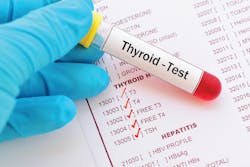Endocrinology screening and reasons behind delayed testing
Ahealth screening is a clinical or laboratory test typically performed on asymptomatic patients to assess their likelihood of having a particular disease or disorder. Health screenings are attributed to early diagnosis of diseases such as cancer (i.e., colonoscopies for colorectal cancer, Pap smears for cervical cancer, and mammography for breast cancer). There are, however, many other screening tests commonly used, particularly concerning endocrine disorders: thyroid-stimulating hormone (TSH) for congenital hypothyroidism in newborns; triiodothyronine (T3) and thyroxine (T4) for determining hypothyroidism or hyperthyroidism; DHEA sulfate for polycystic ovarian syndrome; lipid panel (cholesterol and triglyceride levels) for heart disease, hypertension, and other coronary risks; and blood glucose and hemoglobin A1c for diabetes.
Our endocrine system is characterized by eight major glands and organs throughout the body, including the thyroid gland, pituitary gland, adrenal gland, and pancreas. This system is responsible for regulating a range of bodily functions through the release of hormones — it affects not only growth and development, metabolism, sexual function, and mood, but the general equilibrium of our bodies. Unusually high or low hormone levels may signify an endocrine disorder or disease. Many endocrine screening tests are widely used in the United States, and the recommended frequency of testing varies depending on the disorder.1,2 While endocrine screening tests are critical in the prevention and management of many endocrine and general health disorders, there has been an overall decline of patients seeking appropriate and timely care within the United States.
According to the Center for Studying Health System Change’s 2010 Health Tracking Household Survey, approximately 17% of the U.S. population — one in six people — reported delaying or not acquiring needed medical care at some point in the previous 12 months.3 Thus, poor routine and/or follow-up care can lead to a delayed diagnosis of an endocrine disorder or disease or worsening of a pre-existing endocrine disorder or disease. In either case, the resulting harm may range from a worsening of mild or severe symptoms, progression of disease, or even death.
The purpose of this article is to discuss the reasons patients are avoiding necessary and recommended medical care and screening. Poor access to care is considered one of the greatest barriers to patients failing to receive adequate and appropriate care in the U.S. healthcare system. This barrier can be viewed as multi-factorial, and the most prevalent factors limiting patients’ access to care comes down to four significant reasons: socioeconomic status, health disparities, physician shortages, and the COVID-19 pandemic.
Socioeconomic status
It is no surprise that patients with low incomes tend to face greater difficulties meeting their basic health needs, as well as those of their families, compared to patients with higher earnings. A 2021 report by the Urban Institute showed a direct correlation between patients’ annual income and access to care and overall health status.4 According to the Urban Institute, individuals with incomes at or below 138% of federal poverty line (FPL) — approximately $30,000 per year for a family of three — were more than nine times more likely to be uninsured than those with an income at or above 400% of the FPL. Those with incomes between 139% and 399% of the FPL were more than five times more likely to be uninsured than those with incomes at or above 400% of FPL.
Because they are uninsured, this subset of low-income patients has a much higher level of unmet medical needs and delayed care compared with insured patients. This same study from the Urban Institute examines the likelihood of having an established healthcare provider amongst lower income versus higher income patients. Per the study, compared with families with higher earnings, families with incomes at or below 138% of the FPL were also less likely to have an established source of health care. If the families had an established source of care, however, they were less likely than higher income families to have a relationship with a usual provider.
Additionally, patients with incomes at or below 138% of the FPL are more likely than those with higher incomes to report physical and mental health problems. Among such patients, approximately 26% reported being in fair or poor health, 48% reported having one or more chronic conditions, and 41% cited having a mental or behavioral health condition. In comparison, these same issues were reported in 4%, 35%, and 20% of patients with incomes at or above 400% of the FPL.
Physician shortages
An additional barrier to the access of care stems from the increasing shortage of physicians in the United States. By definition, a physician shortage occurs when there are not enough physicians available to meet patient demand.5 This definition is further elucidated by the World Health Organization (WHO), which has defined a physician shortage as having less than 80% of the physicians needed to meet provider demand by patients.6 According to a report on physician supply and demand prepared by the Association of American Medical Colleges (AAMC), it is projected that the United States will likely face a shortage of between 37,800 to 124,000 physicians by 2034.7 Advanced calculations show a predicted shortage by 2034 of between 17,800 and 48,000 primary care physicians and between 21,000 and 77,100 non-primary care physicians.
Consequently, as this physician shortage continues, patients will continue to suffer because they are unable to access the care they need. They might have trouble finding a doctor to schedule an appointment with, or once an appointment is secured, patients might face extended office wait times. These issues adversely impact patient satisfaction, which may deter patients from seeing healthcare providers as recommended, eventually leading to poor health consequences. Moreover, the AAMC reports that physician shortages impede efforts to remove barriers to care. If patient populations that are underserved by the health system had healthcare-use patterns like populations with fewer access barriers, the United States would see even more significant shortages by 2034: a shortage between 102,400 and 180,400 physicians.
Apprehension to care due to the COVID-19 pandemic
It is widely recognized that the COVID-19 pandemic has had major health and economic impacts across the world. Aside from millions of deaths caused by SARS-CoV-2 infection, the pandemic has affected people’s well-being in many other ways. For example, the COVID-19 pandemic has significantly impacted the diagnosis of endocrinological disorders. Due to the isolation rules in place and shortages of healthcare staff, patients’ access to hospitals had been limited. Consequently, some disorders, such as diabetes and thyroid disorder, have gone undiagnosed at early stages. According to a study published by Matthew Carr and colleagues, the pandemic caused a significant reduction in the diagnosis and monitoring of type 2 diabetes.8 This observation suggests that the COVID-19 pandemic has had a major impact on regular health screening, resulting in underdiagnosis of certain disorders such as type 2 diabetes.
Considering that the pandemic has also had a major effect on individuals’ physical activity, it’s also possible that the number of diabetic cases has increased due to this lack of activity. This issue could also have been expanded to other types of endocrinal disorders such as thyroid malfunction. Symptoms such as fatigue, excess perspiration, and lack of appetite can be manifestations of thyroid malfunction that might have been disregarded by patients during the pandemic. Fortunately, with the available vaccines and normal activities resuming, more people can receive required medical attention to perform screening tests. In addition, patient access to point-of-care tests can tremendously help to identify these disorders during symptom onset and provide preliminary assessment of a patient’s health condition in the comfort of their home.
Cultural competency and healthcare disparities
The United States is one of the most diversified nations, however, its health system falls short compared to its diversity. Recently, the Endocrine Society issued a policy statement addressing the sources and impact of racism in endocrine health disparities.9 According to the statement, black and Hispanic/Latino groups are significantly underrepresented in clinical research studies. This underrepresentation is the most tangible in obesity-related concerns, which commonly prompt referral to a pediatric endocrinologist. The data suggest that primary care providers are more likely to refer overweight children prior to glucose abnormalities if the child is white. This study underscores the presence of racial differences in timing of endocrine referrals among overweight children and underscores the need for future investigation of mechanisms contributing to these differences. Within the adult population, a higher proportion of African Americans and Latinos, compared to whites, report that they have at least one of seven chronic conditions, that include but are not limited to, cardiovascular disease, diabetes, and obesity. These diseases are noted to rank among the costliest medical conditions in the United States.10
Language and communication barriers are also aspects of cultural competence that can impact patient access to care. According to the U.S. Census Bureau’s American Community Survey published in 2015, of the approximately 60 million adults in the United States who spoke a language other than English, some 25 million — 41 percent — reported that they spoke English less than “very well.”11 This lack of efficient physician-patient communication may lead to patient dissatisfaction and poor quality of care, which may translate into a lack of patient adherence and ultimately failure for follow-up and routine screenings.
Patient health literacy is another aspect that tends to be overlooked in healthcare. The Centers for Disease Control and Prevention defines personal health literacy as “the degree to which individuals have the ability to find, understand, and use information and services to inform health-related decisions and actions for themselves and others.”12 Many times, a patient’s health literacy is vastly impacted by their English literacy skills. The 2017 Program for the International Assessment of Adult Competencies (PIAAC) found that 48 million U.S. adults possessed low English literacy skills, while 69 million adults had low numeracy skills in English.13 Although a similar report for 2014 showed no significant change in English literacy and numeracy skills compared to 2017, racial and ethnic minorities were noted to have lower levels of literacy. According to the 2014 PIAAC, Hispanic adults born outside the United States made up approximately one-fourth of low-skilled adults within the country.14 All in all, low literacy may affect patients’ ability to read and comprehend physician instructions, as well as directions on prescription bottles, patient educational pamphlets, and insurance forms.
Increasing patient awareness and access
Endocrine testing is the foundation for detecting a wide range of disorders and diseases that primary care physicians regularly encounter. Most of the time, these disorders and diseases remain undiagnosed due to poor access to care. For example, only 4 of 10 patients with thyroid malfunction are diagnosed.15 In this regard, patient education plays a vital role in increasing awareness around regular endocrine screening. Health care providers and family physicians carry the responsibility of making patients aware of these tests and explaining how to take their symptoms seriously. Nowadays, point-of-care hormone tests are easily accessible and can be performed in the convenience of patients’ homes. These tests analyze levels of key hormones that impact stress, sleep, weight, and mood. These types of tests can reduce the cost for patients and their convenience increases the chance of getting tested following symptom appearance. However, it is important to emphasize that at-home tests should only be considered as a preliminary analysis and further examinations to adopt proper treatment need to be done by clinicians. In addition to patient education, it is also crucial to educate healthcare providers on developing an unbiased perspective when performing both endocrinological screenings and education of their patients.
References
- Givler D, Givler A. Health Screening. Updated May 1, 2022. Accessed May 26, 2022. https://www.ncbi.nlm.nih.gov/books/NBK436014/.
- Endocrine.org. Clinical Practice Guidelines. Accessed May 26, 2022. https://endocrine.org/clinical-practice-guidelines.
- Cunningham PJ, Felland LE. Falling behind: Americans’ access to medical care deteriorates, 2003-2007.Track Rep. 2008;(19):1-5.
- Haley JM, Long J, Kenney GM. Parents with low incomes faced greater health challenges and problems accessing and affording needed health care in spring 2021. Published January 2022. Accessed May 26, 2022. https://www.urban.org/sites/default/files/publication/105304/lowinc1.pdf.
- Heath, S. Understanding physician shortage issues, patient care access. Published December 28, 2017. Accessed May 26, 2022. https://patientengagementhit.com/news/understanding-physician-shortage-issues-patient-care-access.
- Scheffler RM, Liu JX, Kinfu Y, Dal Poz MR. Forecasting the global shortage of physicians: an economic- and needs-based approach. Bull World Health Organ. 2008;86(7):516-523B. doi:10.2471/blt.07.046474.
- Association of American Medical Colleges. The complexities of physician supply and demand: projections from 2019 to 2034. Updated June 2021. Accessed May 26, 2022. https://www.aamc.org/media/54681/download.
- Carr MJ, Wright AK, Leelarathna L, et al. Impact of COVID-19 on diagnoses, monitoring, and mortality in people with type 2 diabetes in the UK. Lancet Diabetes Endocrinol. 2021;9(7):413-415.
- Halpin K, Noel-MacDonnell J, Yan Y. Examining the impact of race and rurality on health differences among overweight youth accessing pediatric endocrinology care. J Health Dispar Res Pract. 2018;12(1):7. Accessed May 26, 2022. https://digitalscholarship.unlv.edu/jhdrp/vol12/iss1/7/.
- Cultural Competence in Health Care: Is it important for people with chronic conditions? Health Policy Institute. Published April 29, 2014. Accessed May 27, 2022. https://hpi.georgetown.edu/cultural.
- US Census Bureau. Detailed languages spoken at home and ability to speak English for the population 5 years and over: 2009-2013. Published online 2022. Accessed May 26, 2022. https://www.census.gov/data/tables/2013/demo/2009-2013-lang-tables.html.
- CDC. What is health literacy? Centers for Disease Control and Prevention. Published February 2, 2022. Accessed May 27, 2022. https://www.cdc.gov/healthliteracy/learn/index.html.
- National Center for Education Services. U.S. adults with low literacy and numeracy skills: 2012/14 to 2017. Accessed May 26, 2022. https://nces.ed.gov/pubs2022/2022004/.
- National Center for Education Services Adult literacy in the United States. Accessed May 27, 2022. https://nces.ed.gov/pubs2019/2019179/index.asp.
- American Thyroid Association. Prevalence and impact of thyroid disease. Accessed Aug. 5, 2021. https://www.thyroid.org/media-main/press-room/.
Sahar Roozbahani, PhD has a PhD in Biomedical Engineering and is currently a Scientific Affairs Liaison at EUROIMMUN US. She is a medical affairs professional with expertise in autoimmune diseases and oncology.
Chibuike Ezeibe, MD is a physician-scientist within the field of medical diagnostics. He is a graduate of Howard University College of Medicine and most recently trained in Obstetrics and Gynecology at Newark Beth Israel Medical Center in Newark, NJ. He currently serves as the Scientific Affairs Clinical Liaison for EUROIMMUN US, one of the world leaders in the field of medical diagnostics.
About the Author

Chibuike Ezeibe, MD
is a physician-scientist within the field of medical diagnostics. He is a graduate of Howard University College of Medicine and most recently trained in Obstetrics and Gynecology at Newark Beth Israel Medical Center in Newark, NJ. He currently serves as the Scientific Affairs Clinical Liaison for EUROIMMUN US, one of the world leaders in the field of medical diagnostics.

Sahar Roozbahani, PhD
Dr. Sahar Roozbahani has a PhD in Biomedical Engineering and is currently a Scientific Affairs Liaison at EUROIMMUN US. She is a medical affairs professional with expertise in autoimmune diseases and oncology.
